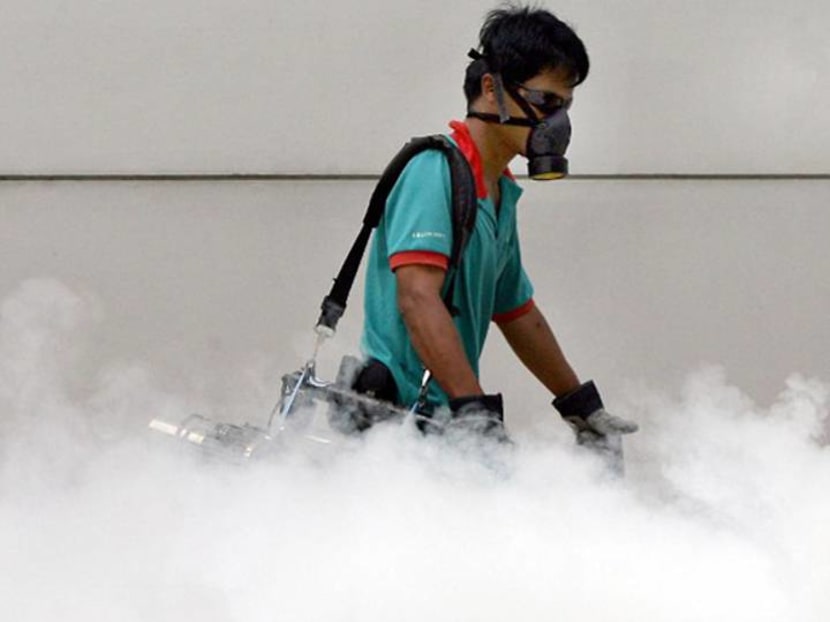Commentary: Why is there another dengue outbreak in Singapore despite all our efforts?
Just as Singapore has turned a corner on COVID-19, we now face the threat of a major dengue outbreak. Saw Swee Hock School of Public Health’s Hannah Clapham and Alex Cook weigh in on why this still happens despite all our mosquito control efforts.

A worker fogs a housing estate in Singapore. (File photo: AFP/Roslan Rahman)
SINGAPORE: It never rains, but it pours. Just when COVID-19 cases in Singapore have fallen back to lower levels, we are experiencing yet another outbreak, this time of a more familiar foe – dengue.
The number of cases reported so far this year has already exceeded the whole of 2021 and is already climbing towards the levels in 2020 when Singapore saw its worst dengue outbreak.
Why is this happening despite efforts by the National Environment Agency (NEA) and the public in mosquito control?
To borrow terms we’ve become familiar with over the last two years of the COVID-19 pandemic, the effective reproductive number – the number of people infected by the mosquitoes infected by one dengue carrier – needs to be kept below 1 to curb transmission. And that isn’t currently happening.
We know some circumstantial factors that may be responsible for the current outbreak. The recent warm weather is conducive to mosquito population growth. DENV3, the current dominant serotype behind the large majority of cases now, has not circulated at such levels before 2021.
But here are two broader factors we think are responsible for why outbreaks like the current one still persist: Ever lower population immunity and ever better diagnostics. Ironically, both are good problems to have.
IMMUNITY IS FALLING BECAUSE OF PAST SUCCESSES
A seeming paradox of dengue epidemiology in Singapore is that despite thousands of cases in recent years, immunity in the population is dropping. It seems to defy logic until you flip it around: Immunity is falling, so dengue can spread more easily.
Low levels of transmission over the last 50 years, thanks to community and government successes in vector control, mean that fewer people have been exposed to dengue. With more people susceptible, a single infected mosquito has more chances to pass on the virus, meaning that controlling the mosquito population has to be increasingly effective to get the same results.
Every few years, NEA and the Health Sciences Authority screen residual blood donations for past dengue infection, and each time over the last decade they have done so, the prevalence has fallen. In 2004, about one in three 30-year-olds had had dengue before and this fell to about one in four by 2017. The fall was generally starker among those aged 45, with prevalence falling from about 74 per cent to 48 per cent.
So how do we reconcile the paradox of the falling prevalence of dengue with the large numbers of cases diagnosed in recent years?
The short answer is that we are better now at detecting dengue infections than in the past. The public is also on higher alert for potential infections, thanks to COVID-19.
Dengue and COVID-19 share some early clinical symptoms, like fever, body ache and fatigue, so more may have sought medical attention in the past two years or so. The availability of rapid diagnostics in GP clinics is another factor.
In a nutshell, though overall the prevalence of dengue has fallen over the years, we are more susceptible to getting infected if exposed to the virus and more adept at diagnosing infections.
So does this mean we just have to accept dengue, as it is for evermore? We don’t think so.
Of course, there are small steps most of us are already familiar with, such as removing stagnant water, using the myENV app to get alerts about clusters, as well as the increased use of sprays, long-sleeved and legged clothing, and residual indoor spraying around the home.
But scientists have always sought out more upstream interventions in control that could create a step change in outcomes.
PROMISING STRATEGY IN WOLBACHIA MOSQUITOES
Fortunately, there are long term technological solutions around the corner, the two most likely over the years ahead being the use of Wolbachia mosquitoes and dengue vaccination.
Singapore has been leading the way internationally in using Wolbachia mosquitoes since 2016 in a suppression strategy – where male mosquitoes infected with the Wolbachia bacteria are released to mate but the resultant eggs cannot produce offspring, thus making the wild population crash.
The data from the pilot field sites in Tampines and Yishun over the last few years suggest the approach is very successful in cutting mosquito populations there.
But at a pilot stage, the effects are mainly entomological – we see a tenfold reduction in the number of female mosquitoes around release sites.
As this strategy moves towards larger-scale implementation, the effects should start to manifest epidemiologically, and we should see falling dengue case counts around release sites, as has started to transpire around the earlier release sites in Yishun and Tampines, where NEA reported a fall in 2019 of up to 88 per cent in dengue incidence.
An NEA factory running in Ang Mo Kio produces up to two million Wolbachia mosquitoes a week for release and aims to breed about five million a week. The aim is to hopefully cover larger tracts of the population with this technology than ever before, making genuine island-wide control start to look more science fact than science fiction.
DENGUE VACCINES LONG TIME IN THE MAKING
The other potential major shield against dengue will be vaccination. The development process of vaccines for dengue has been long and winding.
There is one vaccine licensed for use in Singapore, but it’s targeted only at those who have been infected before and below 45 years of age. Because most in Singapore under 45 likely have not been infected before, fewer are able to be vaccinated than their peers in other countries of Southeast Asia.
However, other vaccines are under development including promising candidates by Takeda and the US’s National Institute of Health. The Takeda vaccine is being considered for approval by the European Medicines Authority – and it will be vital for us to assess its suitability here given Singapore’s unique epidemiology.
The efficient roll-out of COVID-19 vaccines in Singapore offers hope that a dengue vaccination programme can be effected once a broadly-suitable vaccine becomes available.
LESSONS FOR DENGUE CONTROL FROM COVID-19 CONTROL
Just like how antivirals like Paxlovid have been deployed as the next line of defence after COVID-19 vaccines in Singapore and around the world, the development of effective antivirals will also be important.
Depending on how they work, antiviral may help lead to a shorter illness, less severe disease or help reduce transmission, depending on how they work. A number of candidates are in trials, but none are licenced yet.
During the COVID-19 pandemic, the world has shown it is capable of rapid investment and international collaboration to understand the biology, develop vaccines and learn how to control this new disease.
The hope for those of us working in infectious diseases is that these successes could galvanise solutions to endemic diseases like dengue – a disease that has been around much longer but against which we have fewer tools.
So while the recent rise in dengue cases may seem alarming, this is a reflection of past successes in vector control and better testing capabilities. Advances lie on the horizon and can take Singapore to the next stage of dengue control. But for now, let’s remain diligent in doing our mozzie wipeout while we work our way there.
Hannah E Clapham is an Assistant Professor at the Saw Swee Hock School of Public Health, NUS. Alex R Cook is Vice Dean (Research) and Associate Professor at the same school.













